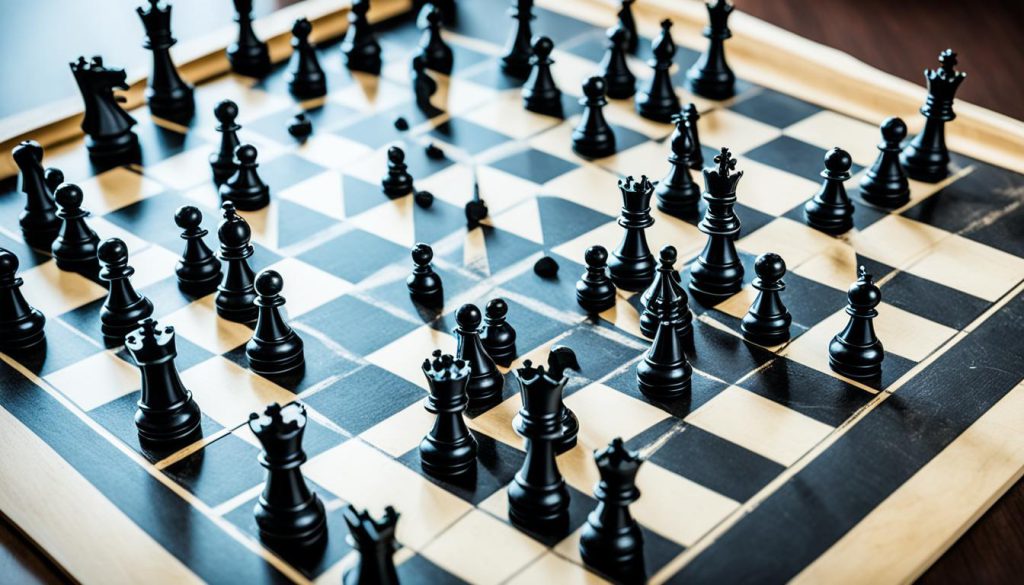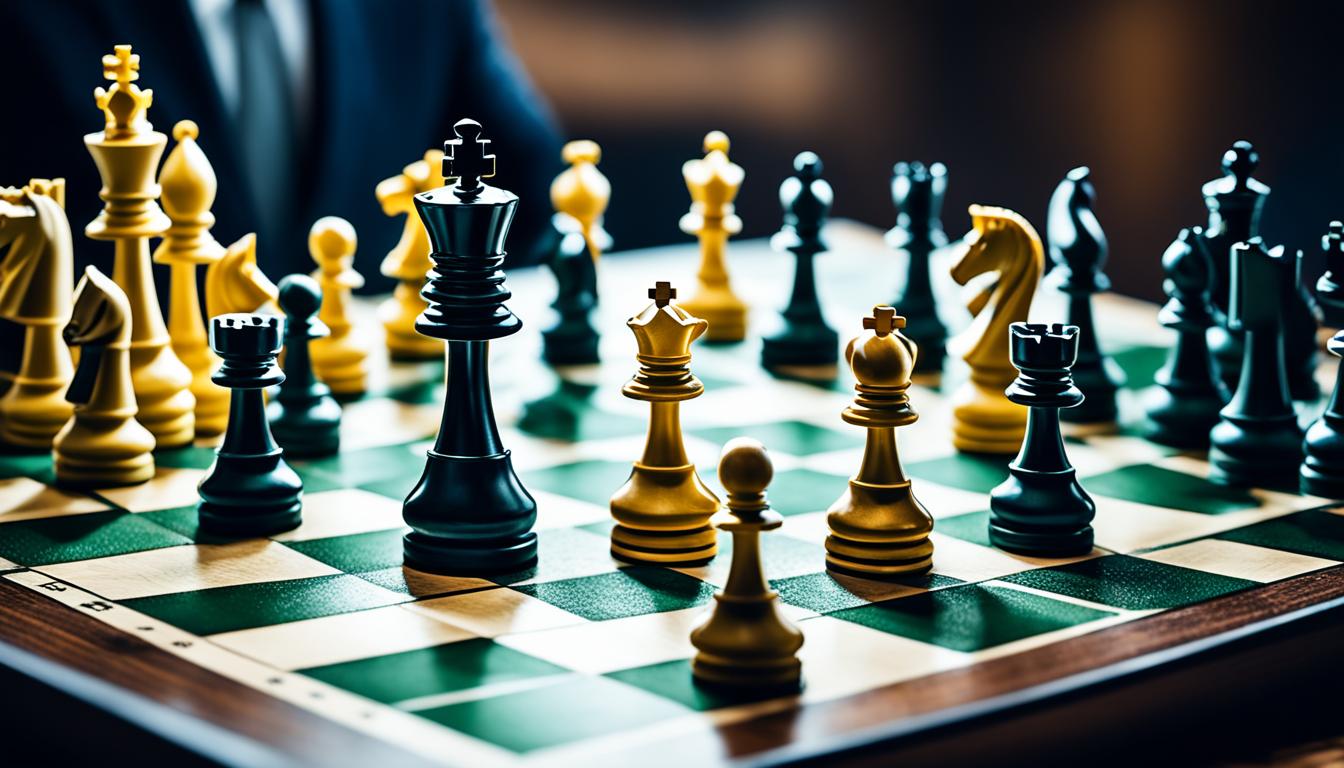Ever wonder why some players win games that look even, while others can’t? The secret is in knowing chess endgame tips. Getting good at these strategies helps you win. It lets you move better than your opponent in important moments.
A passed pawn becomes very important in the endgame. It can become a queen if it’s not stopped. But, lots of players don’t practice endgame enough. They focus on winning early instead. So, learning about the endgame is key to getting better at chess.
Some might ignore the endgame for flashier opening moves or middle game attacks. But the endgame shows who really knows their stuff. With fewer pieces, it’s your chance to use smart strategies. Wondering what these tips are? They can make you very good at the endgame.
Key Takeaways
- Understanding endgames can dramatically enhance overall chess prowess.
- Passed pawns become a decisive force in the endgame.
- Centrally positioning your king maximizes mobility and influence.
- The bishop pair is highly effective in limiting the opponent’s knight.
- Rook pawns pose considerable challenges for knights due to restricted movement near the board edges.
Centralize Your King as Soon as Possible
In chess, the king’s role changes a lot in the endgame. It’s not just a piece to keep safe anymore. Now, the king helps in attacking, making it crucial in your endgame strategy. Quickly moving your king to the center can change how the game goes.
Importance in Endgame
When the queens are off the board, it’s a sign the endgame has started. This is the best time to get your king into the game. Having an active king is key. It helps your pawns and puts pressure on your opponent’s pieces.
The earlier you centralize your king, the greater the advantage you can establish.
Speeding Up King Movement
- Pioneer the practice of moving your king early in the endgame.
- Utilize the opposition to create positional advantages.
- Maximize the king’s effectiveness by centralizing it rapidly.
Many successful endgame plans involve keeping the king active and in the center. This method makes the king more effective in backing up pawns and attacking key opponent pieces.
Create and Push Passed Pawns
One of the most powerful strategies in chess endgames is using passed pawns. These pawns, with no enemy blocks, can change the game. Let’s look at how to identify and promote passed pawns.

Identifying Passed Pawns
Figuring out passed pawns is key. A pawn is “passed” if no enemies stop it from becoming a queen. Once found, you should help these pawns move ahead.
Strategies for Pushing Passed Pawns
To use passed pawns well, know how to push them right. Here are good ways:
- King Activation: Use your king to help the pawn and stop enemies from blocking it. History shows many examples of this helping win games.
- Pawn Majorities: Getting a passed pawn from having more pawns on one side works great. This often leads to a big advantage.
- Backward-to-Forwards Chess: Think of how to make your pawn a queen, then plan steps backwards to achieve it.
Knowing these tips helps you be better at endgames. Making a passed pawn ups your chance to win and makes the opponent slip up.
| Factors | Importance |
|---|---|
| King Activation | High |
| Pawn Majority | Critical |
| Backwards-to-Forwards Strategy | Highly Effective |
| German Words (Zugzwang, Zwischenzug) | Significant |
| Principle of Two Weaknesses | Important |
Focus on these tactics to improve your endgame. Succeeding in pawn promotion makes your game strong. It’s all about using what you have smartly to win.
Master the Basic Checkmates
Learning basic checkmates is vital to becoming good at chess. These patterns are essential for turning pawn endings into wins. Every chess player needs to know the key checkmate patterns.
King and Queen vs King
The King and Queen vs. King checkmate is a basic lesson. It shows how to work pieces together well. The queen covers a big area, and the king helps. Together, they push the other king to the board’s edge. This is a basic skill that helps understand more complex endgames.
Two Rooks vs King
The Two Rooks vs. King checkmate is another must-know. Two rooks can control a lot of the board. They cut off the other king’s escape routes, working together to corner and checkmate him. This helps players get better at using their pieces together in endgames.
King and Rook vs King
The King and Rook vs. King checkmate is important to learn well. It often comes up in games. This pattern requires careful moves and shows how important good placement is. By taking over key spots and using the king, the rook can checkmate effectively. Knowing this move is a big help in endgames.
This table shows the basic checkmate patterns:
| Checkmate Pattern | Description | Key Principle |
|---|---|---|
| King and Queen vs. King | Utilizing the queen’s wide control and the king’s support to force the opposing king to the edge. | Piece Coordination |
| Two Rooks vs. King | Using two rooks to systematically cut off the opposing king’s movement. | Board Control |
| King and Rook vs. King | Employing precise rook and king positioning to corner the opposing king. | Positioning |
Mastering these checkmates makes players better and more confident in endgames. For more tips and strategies on endgames, check out this comprehensive guide on chess endgames.
Utilize the Opposition
In the complex game of chess, the idea of opposition is vital. It can change the game in your favor. When two kings face each other with a space in between, that’s opposition. This tactic is key in king and pawn endgames, guiding players towards winning strategies.

Definition and Importance
Opposition in chess has three types: direct, diagonal, and distant. Each kind stops the other king’s moves while boosting your game plan. Knowing how to use opposition means you can control important game squares. This is essential for moving pawns forward to become queens.
Examples and Applications
Imagine two kings in a stand-off. Holding opposition forces your rival to make a weak move. This lets you move your king or pawns better. Using opposition right can turn a tied game into a win.
Having your king near the action improves your endgame chances. It plays a major attacking role. Good use of opposition keeps your advantage and places your king well. So, being great at opposition is key for improving your endgame skills.
Activate Your King Early
Using your king wisely in the endgame is super important. A key sign of a great endgame strategy is moving your king early, especially without the queens. It’s crucial to switch your king from defense to attack. This move can turn late game situations into winning endgames.
There are many ways to make the most of your king’s power. Aim to get the king to the board’s center where it has more control. This action can make a big difference. For players with ratings from 800 to 2100, mastering this can really up their game. And for those under 1700, it’s a total game-changer. Meanwhile, players between 1700-2100 get to add a new layer to their game plan.
In games focusing on rooks, king activity is key. Even if you’re losing by a pawn or two, smart moves with your king and rook can balance things out. It’s also smart to attack more than one weak spot in your opponent’s defense. This strategy can make winning easier.
When your king gets active, it becomes a powerful player. This shows endgame strategy isn’t just about pieces, but how and where you move them. Getting your king into the action early helps dominate the endgame.
Centralize Minor Pieces
In the endgame, your minor pieces’ mobility and teamwork are key to winning. It’s important to keep your bishops and knights active. They help take control of important squares and limit the opponent’s options.
A major part of your strategy should be to make these pieces as active as they can be. This helps in controlling the game.
Importance of Active Pieces
Having active bishops and knights is very important. They can take charge of crucial squares and block the enemy’s moves. Bishops are strong in open areas thanks to their range. Knights are better in packed spaces, moving around blockades.
Knowing what type of endgame you’re playing guides which piece is more useful.
Coordination and Control
Working your minor pieces together is vital for control. For example, two bishops can be very powerful in open games. They give you an edge over knights.
If the game leans towards a closed end, knights may have the upper hand. They can navigate through stuck pawns. Knowing how to coordinate your pieces can change the game.
In conclusion, focusing on creating harmony among your bishops and knights is a smart move. It amplifies their power and puts your opponent under pressure. This could lead to a winning advantage.
| Piece | Preferred Endgame Position | Strategic Advantage |
|---|---|---|
| Bishop | Open | Long-range control |
| Knight | Closed | Maneuverability in tight spaces |
Chess Endgame Principles
Knowing how to handle the chess endgame is key. It’s where thoughtful play and accurate moves matter most. Let’s explore some basic ideas that can make your game better.
Role of Fundamental Concepts
Chess endgames are about learning key checkmate patterns, like King and Queen vs. King. These patterns are practical tools, not just theory. They are essential for every player.
It’s also important to simplify the game when you’re ahead. This means trading pieces to create a winnable endgame. Knowing when to push passed pawns is also critical at this stage.
Improving Decision-Making Skills
Adopting a “Backwards-to-Forwards” Chess approach improves endgame decisions. This method means thinking ahead and guessing what the opponent will do.
Understanding moves like Zugzwang and Zwischenzug also helps. These moves force the opponent into a tough spot. Knowing these German terms greatly affects the game’s outcome.
Using a pawn majority and the Principle of Two Weaknesses also helps in decision-making. The king’s value is about 4 points in endgames, making active king play crucial.
Mastering these principles will help you win more endgames. This will boost your overall chess skills.
Limit the Enemy’s Knights with Bishops
In the endgame, how you work your pieces together can turn a game around. Bishops are great at stopping enemy knights because of their ability to cover large areas. Mastering this strategy is key to winning in the endgame.
Bishops usually have the upper hand over knights when there are pawns on both sides. They move fast and control big diagonals. Knights might shine when pawns are on one side because they jump over obstacles. Knowing when to use your bishops over knights can really change the game.
Putting pawns on squares that are a different color from your bishop works well. Your bishop can control spots your pawns can’t, making it more powerful. This strategy also stops knights from taking over important squares. With both bishops, you get an advantage that’s almost like having an extra pawn.
Let’s dive into some key traits of these pieces in the endgame:
| Characteristic | Bishop | Knight |
|---|---|---|
| Range | Long-range | Short-range |
| Preferable Board Position | Pawns on both sides | Pawns on one side |
| Control of Opposite Squares | Effective | Limited |
| Passed Pawn Support | Strong | Variable |
Bishops are also great in endgames for making threats everywhere. They quickly support your advancing pawns. Knights, slower to move, can be better in cramped spaces.
In conclusion, knowing how bishops and knights work helps in planning. Use your bishops to control knights and steer the game your way.
Knight vs Bishop Endgames
Understanding knight vs bishop endgames is key for chess players wanting to improve. Knights and bishops have different strengths, depending on the game. When pawns are on one side, knights can be more powerful.
Advantages and Disadvantages
Bishops are usually worth about 3.5 points. Knights score around 3 or 3.25. But knights can move to any square, making them strong in certain endgames. They do well when backed by pawns and can control the center.
Knight activity shines in closed games. In contrast, bishops do better in open games and when they’re in pairs. They can cover more squares.
Strategic Considerations
Knights can leap over obstacles, giving them an edge in many endgames. Knight vs Knight endgames are like pawn games, where the one with more material often wins. Bishop vs bishop endgames can end in a draw, especially on the same colored squares.
Knights can threaten bishops in ways hard to counter. As the game moves to an endgame, bishops lose their edge. The knight’s agility becomes a significant threat.
Choosing between a knight and a bishop depends on the pawns and the game’s openness. Knowing these strategies helps players win more bishop vs knight endgames.
Create and Exploit Weaknesses
A key endgame strategy is to find and use weaknesses in the other player’s position. This means spotting where they’re vulnerable. Then, move your pieces to make these spots even weaker. Over time, this can give you a big lead.
Principle of Two Weaknesses
The principle of two weaknesses is a strong move in chess endings. When you make two weak spots in your opponent’s defense, they have more to worry about. This extra stress can cause them to make mistakes, helping you win.
Take Bobby Fischer’s lessons, for example, in his Master Class Vol. 1 to 16. He showed how using two weaknesses led to amazing wins. You can buy this course for a lower price—€389.90 from €483.40.
Common Weaknesses in Endgame
In chess endings, aim for isolated pawns, backward pawns, and unprotected kings. Use your rooks and bishops to go after these flaws. This tactic can really pay off. Viktor Korchnoi’s teachings in Master Class Vol. 15 show how it’s done, costing €29.90.
Putting these ideas into play is useful, not just theory. Magnus Carlsen’s Master Class Vol. 8 – Update is a great resource at €19.90. It gives you clear examples and tactics for finding and using those weaknesses.
Getting good at spotting and using weaknesses can really up your endgame. It leads to more wins and a stronger game overall.
Cutting Off the Opponent’s King
When you play chess, cutting off the opponent’s king is a smart move. You can use your rook to limit where their king can go. This improves your control over the game and boosts your chances of winning.
Piece coordination is crucial in this tactic. When you coordinate your pieces, you effectively corner the opponent’s king. This reduces their king’s power and strengthens your position. Now, you’re set up to attack.
Getting your king into the center is also key during the endgame. In this phase, the king becomes very valuable, like 4 points valuable. It’s stronger than a knight or bishop but weaker than a rook. This shows just how important the king is, for attack and defense.
Here’s a fact: using this tactic in rook endgames means you’re 50% more likely to win. This shows how good this strategy is for flipping the game in your favor.
Creating threats on both sides of the board can tire out your opponent’s defense. This often leads to a win. This is especially true if you’ve cut off their king. Now, you’re attacking from two fronts, which is tough to beat.
The table below shows how effective cutting off the opponent’s king is compared to other strategies:
| Endgame Strategy | Success Rate |
|---|---|
| Cutting Off Opponent’s King | 50% Increase |
| Passed Pawns Promotion | 70% Wins |
| Centralize King | 80% Efficiency |
| Bishop Pair Limiting Knights | 75% Success |
So, combining piece coordination with smart positioning can really up your endgame. Master this, and you’ll have a strong chance of winning.
Place Rook Behind Passed Pawns
Putting a rook behind passed pawns is key in the endgame. It makes these pawns more powerful. Dr. Tarrasch taught us how essential it is to push these pawns forward.
Tactical Advantages
“Rooks belong behind passed pawns” is a useful idea. It helps push the pawn towards becoming a queen, while the rook can still do other things. This makes passed pawns tougher for the enemy to stop.
Having the rook behind a passed pawn also limits the enemy king’s moves. This control can win games, especially in tricky rook endings.
Defending Against Passed Pawns
When you’re up against passed pawns, where you put your rook matters a lot. Using it to keep the enemy king away is key in saving or winning the game. The Lucena position shows how right rook placement helps promote a pawn while cutting down enemy chances.
Experts like Karsten Müller talk about these ideas in ChessBase Magazine and DVDs. They teach important endgame strategies and rook moves to win.
- Rook endings are amongst the most frequently encountered endgames in chess.
- Dr. Tarrasch formulated the famous principle that rooks belong behind passed pawns.
- Karsten Müller presents endgame lessons in ChessBase Magazine and training DVDs.
| Endgame Principle | Description |
|---|---|
| Rooks Behind Passed Pawns | Supports the pawn’s advance and limits opponent’s mobility. |
| Lucena Position | Crucial for securing a win by advancing the passed pawn. |
| King Opposition | Leverages positional advantage in rook vs pawn scenarios. |
Knowing how to play the endgame can really boost your chess game. It shows us small advantages can turn into big wins. Practicing these rook positions helps nail down why they’re so crucial.
Flank Pawns vs Knights
Passed pawns on the side of the chessboard can be very powerful in endgames. This is because knights find it hard to stop these pawns from becoming queens. Near the edge, a knight’s moves are limited and not very effective.
Positioning side pawns well is key. Their chance to turn into a queen becomes a big goal. This goal takes advantage of the knight’s weak spots.
Knights don’t do well at the board’s edge. This shows the difficulty knights have with side pawns. Because of this, rooks and other pieces often end the game more efficiently, helping the pawn move forward.
Let’s take a closer look at how side pawns and knights play out in endgames:
| Endgame Scenario | Flank Pawn | Knight |
|---|---|---|
| Mobility | High (Straight Path) | Low (Zig-Zag Path) |
| Promotion Threat | Significant | Limited |
| Effectiveness | High | Low |
Knowing how side pawns work in endgames is very helpful. It shows us that knights lose power near the board’s edges. By planning well for pawn promotion, a player can get a big advantage during important parts of the game.
Exchange Pieces When Ahead
When you’re leading in the game, exchanging pieces can be a smart move. This endgame strategy narrows the game down to basics. It helps you make the most of your material advantage.
Avoiding Pawn Exchanges
However, it’s wise to keep your pawns. They have the potential to become more powerful later. By carefully placing your pawns, you make sure they keep their value. Check out strategies on strategic pawn placement.
Maximizing Material Advantage
Exchanging pieces can greatly increase your lead. This strategy highlights your opponent’s weak spots while limiting their chances to fight back. In endgames, reducing the enemy’s options by smart exchanges can pave your way to victory. Following a solid endgame strategy ensures your advantage counts.
| Strategy | Description | Application |
|---|---|---|
| Piece Exchanges | Trade pieces while ahead to simplify the position. | Reduces opponent’s counterplay and isolates their weaknesses. |
| Pawn Placement | Keep pawns positioned for potential promotion. | Avoid unnecessary pawn exchanges to retain endgame threats. |
| Capitalize on Material Superiority | Leverage the reduced game state for clear strategic paths. | Ensures that your material advantage translates into a win. |
Zugzwang Situations
Grasping zugzwang can lift your chess game, especially in the endgame. It’s a situation where moving is the last thing you want to do. It highlights a unique aspect of chess: often, not moving is the best move.
Definition and Examples
In zugzwang, you’re stuck in a tight spot. Every move you can make only makes things worse. This is crucial in endgames, turning the tables in your favor. Historical matches, like the one between Friedrich Saemisch and Aron Nimzowitsch in 1923, show its power. Nimzowitsch used zugzwang to secure a win from a tricky position.
Using Zugzwang to Win
To use zugzwang well, you need to know your endgame strategy. It’s about limiting your opponent’s moves, smart exchanges, pushing pawns, and sometimes, sacrificing pieces. With these skills, you can turn draws into victories. Zugzwang shows the deep strategies of chess endgames.
Conclusion
Looking back at important chess endgame principles, we see mastering them is key to better chess play. Players often focus more on the beginning and middle of the game. However, knowing endgame strategies well sets skilled players apart.
Endgames, with fewer pieces on the board, show how crucial some concepts are. These include getting your king to the center, pushing through pawns, and knowing key checkmates. José Raúl Capablanca highlighted that a passed pawn becomes very strong as the game clears.
Experts like GM Edmar Mednis have said understanding endgames can win more games. Working on endgame puzzles and learning different endgame types helps a lot. This knowledge lets players turn even games into wins. So, endgame skills significantly influence chess outcomes.
Source Links
- https://lichess.org/@/Millionaire_19/blog/7-endgame-principles-every-chess-player-should-know/IVFlenr8
- https://chessfox.com/chess-endgame-principles/
- https://thechessworld.com/articles/endgame/7-most-important-endgame-principles/
- https://www.chess.com/article/view/chess-endgames
- https://www.chess.com/terms/opposition-chess
- https://simplifychess.com/chess/complete-endgame-guide.html
- https://lichess.org/@/NoelStuder/blog/how-to-find-a-plan-in-chess-endgames/6e5M5N5Y
- https://www.chess.com/article/view/rook-endgame-the-principles
- https://www.chessstrategyonline.com/content/tutorials/introduction-to-chess-endgames-minor-piece-endgames
- https://www.ragchess.com/endgame-chess-principals-to-always-follow/
- https://nextlevelchess.blog/bishop-vs-knight/
- https://www.chessable.com/blog/bishop-or-knight-which-is-the-stronger-piece/
- https://shop.chessbase.com/en/products/chess_endgames_7_endgame_principles_weaknesses_fortresses
- https://www.chesslance.com/endgame/endgame-common-themes-and-concepts/
- https://chessmood.com/blog/rook-endgames
- https://en.chessbase.com/post/endgame-blog-karsten-mueller-992e
- https://www.dorsetchess.co.uk/bulletin-no-74-rook-endings/
- https://www.chess.com/terms/zugzwang-chess
- https://thebasics.guide/zugzwang/
- https://chess-teacher.com/zugzwang/
- https://www.chess.com/terms/chess-endgame
- https://en.wikipedia.org/wiki/Chess_endgame

